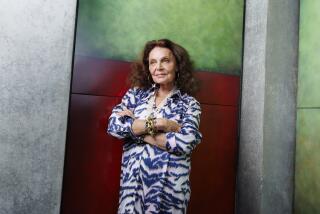Although the colorful 1980s setting of “Wonder Woman 1984” was purposeful for the story of the superhero sequel, the time period was also an opportunity for the film’s crew members to flex their creative muscles. Director Patty Jenkins, who cowrote the script, brought back costume designer Lindy Hemming and production designer Aline Bonetto, who both worked on 2017’s “Wonder Woman,” to craft the vibrant aesthetic of the piece.
And although most of the 1980s style and taste has become a punchline, Jenkins found much to like.
“Just like no person is a caricature, no era is a caricature,” she notes. “With the ‘80s, I found myself focusing on the great style and the great fashion and the great music as much as the funny [aspects]. It was a great era. For us, it was about touching on all those different things that were happening at the same time but then making sure the color palette kept everything together.”
Early on, the team had a lot of discussions about that color palette, which needed to be bright and in-your-face to represent the excesses of 1984, especially with its villains Max Lord (Pedro Pascal) and Barbara Minerva (Kristen Wiig). For Bonetto, it was about uncovering what you remember about the era and then augmenting it with research.
“The memories we have of this period is that the ‘80s bring a lot of color everywhere,” Bonetto says. “Everything was flashy with warm colors. You remember Basquiat with his colorful paintings. That was the ‘80s, really. But when you look at references, even your memories are not as strong as the real thing was. When you see pictures, you think, ‘Oh, God, we were wearing clothes like that!’ So we wanted to bring the color back as it really was.”
“In the beginning, I was kind of horrified it was the ‘80s,” Hemming admits. “But what was fun was the idea of being colorful, and the research was very interesting. Having not really worn many of those clothes myself, I set about researching, looking back through paper patterns, fashion magazines, photographs and events that happened.”
The film’s opening sequence, set in a large suburban mall, reveals that colorful tone. Bonetto found the now-defunct Landmark Mall in Alexandria, Va., and replicated 65 stores from the era, taking over three floors and making everything from the cash registers to the shop windows period-accurate. The scene also brings the first glimpse of Wonder Woman’s revitalized blue, red and gold armor, which Hemming redesigned for the film.
“In the first film, she spends most of her time running through mud, jumping over fences, climbing buildings, and it had to look broken down and beaten up,” Hemming says of the superhero, played by Gal Gadot. “But in this film, Patty wanted it to look much more like it fit in with the ‘80s world. It looks more golden, more translucent and much more colorful. Patty wanted it to glow, especially when she’s flying, with light coming off it. You need to be able to see the texture and the depth more than you might if you’re lighting a scene for the trenches.”
Whereas Wonder Woman’s armor feels more illuminated, Diana Prince’s daywear is less obvious. Both Hemming and Bonetto wanted to emphasize Diana’s classic style without connecting her clothes or her apartment too closely to fleeting fashion trends. Her apartment is in the Watergate (the interiors were built in a London studio; the real exteriors were shot in D.C.) and Bonetto focused on designing it as an ageless space.
“She has a global view of the world and knowledge of ancient civilizations,” Bonetto notes. “I wanted her apartment to have no special link to the time, but to always be elegant. I wanted it to be really pure, with pure lines, not too much details, not too much color. I was quite happy to give another point of view on [the Watergate], not as attached to something so negative. It’s a beautiful building.”
Diana’s clothes, which Hemming and her team designed and constructed from scratch, were inspired by such designers as Claude Montana, Calvin Klein and Ralph Lauren but meant to feel classic with a minimal color palette so she could stand out next to Barbara (and, to a lesser degree, to Steve Trevor as played by Chris Pine, who rocks an iconic fanny pack).
“I was anxious not to make her look too out-and-out ‘80s,” Hemming says. “I wanted to keep her a gentle, sophisticated version of the ‘80s. If she suddenly became a fashion mark, I don’t think that would really work for her character. She’s someone with very good taste who’s living in the ‘80s and wants to pass among the ‘80s but doesn’t want to look like a fashion model.”
One of the biggest challenges — and most exciting aspects — of the film was shooting at real locations in Washington, D.C. The filmmakers used the National Mall, several Smithsonian museums, including the National Air and Space Museum, and the interior of a Metro station, even staging one of the chaotic finale scenes in the garden of the Watergate. Bonetto, who also used locations in Spain and England to round out the action, wanted things to feel period-accurate even though the story is fantastical.
“You want people to absolutely take it all in for real,” she says. “So you have to think about all the environments and ensure they are real enough that when it all comes together you will accept the superhero. For this it was based on the period, like the first one, which was based even earlier, and you have to put in the majority of historical elements, otherwise you will lose everything.”
More to Read
From the Oscars to the Emmys.
Get the Envelope newsletter for exclusive awards season coverage, behind-the-scenes stories from the Envelope podcast and columnist Glenn Whipp’s must-read analysis.
You may occasionally receive promotional content from the Los Angeles Times.










